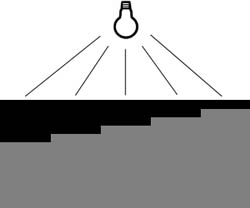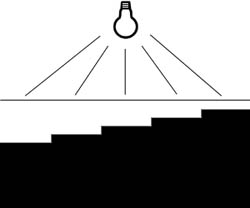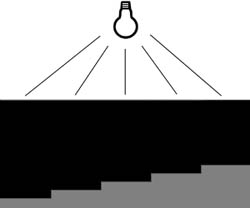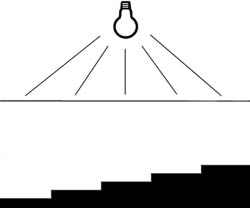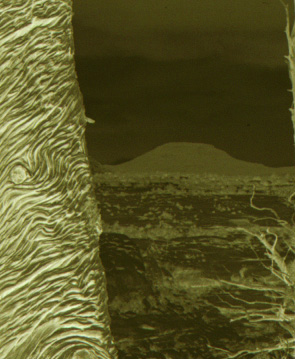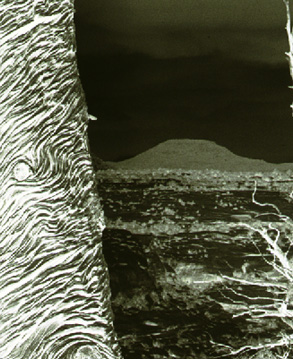 |
||||||
|
|
||||||
|
Revised 25 March 2006 |
||||||
|
Less is More: by Ed Buffaloe
The technique uses lithographic film, which is relatively cheap. Liam recommends Arista APH ortho/litho film, which unfortunately is no longer available. Today, making enlarged negatives has been largely replaced by digital processes but, in my experience, the analogue processes are much sharper, if they can be mastered. How Reversal Works The reversal process for making copy negatives is described in Photographic Facts and Formulas (by E.J. Wall, Franklin I. Jordan, and John S. Carroll), published by Amphoto. The technique is relatively simple and is essentially the same as that used for black and white motion picture film. The film is first developed normally--during which all exposed silver halides are converted to silver. But, instead of fixing the image at this point, the developed silver is removed with a non-halogenating bleach. What remains is unexposed silver halide. This remaining silver halide is then re-exposed under normal room light and developed, producing a negative image. No fixing is necessary, as there is no further halide to be removed. The primary difficulty with this technique is controlling contrast--special reversal films were usually recommended which are no longer available.
Flashing to Control Density Film contains much more silver halide than is necessary for a continuous-tone image, most of which is removed during fixation. If one gives an exposure suitable for producing a normal positive image from a negative and bleaches away the silver after development, the remaining halide will be too thick and the reversed image in turn will be far too dark and contrasty for most uses. The trick for obtaining a usable continuous-tone copy negative is to increase the initial exposure, then give an additional overall flash exposure to increase the depth of the latent image. After the film is developed and bleached, the remaining layer of halide will be relatively thin and will produce a clean continuous-tone image when exposed and developed. The flash exposure controls the high value density of the copy negative. More exposure produces increasingly less density in the final negative. Liam Lawson has told me that he came up with the idea for the flash exposure because Judy Siegel (of Post-Factory Photography) needed a low density negative for gum printing. Without the flash, the resulting negative was too dense for her use. Lawless recommends using a 15 watt bulb, mounted on the ceiling and connected through a rheostat, for making flash exposures, but in his correspondence with me has also noted that he had to recalibrate flash times when he changed bulbs. For this reason, I prefer to use the enlarger lamp for the flash exposure. While it is necessary to dismount the negative and stop down to flash, one is always assured of an exposure that is in the correct proportion to the base exposure. On the other hand, Lawless’ method is faster if you have a lot of negatives to make.
Initial Testing To calibrate, perform the following three tests. 1. The first test is to determine the correct exposure for a film positive. Use a negative of normal density and contrast. Start with the enlarger lens at f/8 and make a series of exposures at 1-second intervals. If the correct exposure proves to be too short (less than 5 seconds), either make another test strip at .5-second intervals, or stop down to f/11. Other options are to use a neutral-density or variable-contrast filter to reduce the light output of the enlarger, or adjust the output of your cold light head. Lawless recommends choosing the correct exposure in the stop bath--note the time from the strip that gives a normal-looking, if somewhat dark, positive image, with a good tonal gradation . Make sure you have the desired detail in the high values. It is not necessary to fix this test strip. This exposure controls detail in the high values. 2. The second test strip is to determine the correct exposure factor to apply for reversal processing--using the exposure you have chosen in step one, expose a piece of film at 3X, 4X, 5X, 6X, and 7X that exposure, and process by reversal (as described below--use a flash exposure of 6 seconds at f/32, or 3 seconds at f/22 for this test). Once you know the correct factor to apply, you will be able to determine the correct “base” exposure. The multiplication factor controls contrast. If you have used a negative of normal contrast, it should require a factor of 3X or 4X. If the resulting negative suits your needs, you are done testing, but if its overall density is not suitable, proceed to step 3. Once the multiplication factor is determined, you can use it for all future negatives of normal density and contrast. As the multiplication factor increases, so does the contrast of the resulting negative. Excellent results can be achieved from very dense originals, but very thin originals are not suitable for the process. If your test results are too dense overall, perform the test again and double the flash exposure. 3. The third test strip is to determine the correct flash exposure. The flash exposure we used in test 2 may not be suitable for the process you intend the negative for. Make a negative with the base exposure you have chosen in step 2, give it a series of flash exposures at intervals of 2, 4, 8, 16, and 32 seconds at either f/32 or f/22, and process by reversal. Use a densitometer to determine the correct maximum density. See page 2 for suggested maximum densities for various processes. If you do not have a densitometer, you will have to print the negative to determine if its density and contrast range are suitable. The flash exposure determines the density of the high values in the copy negative--the more flash exposure you give, the less dense the high values will be. The flash has virtually no effect on the low values. Once you have performed these three tests on a “normal” negative, you will only need to perform test 1 for a typical negative in order to determine its “base” exposure time. If you have a negative that is unusually dense or thin, or of very high or low contrast, you may have to perform the other tests as well. The Reversal Process, Step by Step
2. Remove the film, stop down 4 stops, and give a flash exposure. The flash exposure will vary, depending upon the density of the original negative and the process you wish to use the copy negative for. Remember: with reversal, less is more. The less flash exposure you give, the more density will result in the copy negative. With our base exposure made at f/8, the flash exposure time we used most often was 6 seconds at f/32, or 3 seconds at f/22. 3. Develop for 6 minutes in a standard paper developer at normal strength. We did all our tests using Dektol (1:2), but any standard paper developer at its normal dilution will suffice. Liam states that reducing developing time reduces contrast, but that very short developing times increase fog levels in the enlarged negative. He doesn’t recommend adjusting contrast in this way. Remember, you are developing film, not paper--it needs to be developed fully, so that all exposed halides are reduced to silver. Replace with fresh developer on a regular basis for consistency. A post on APUG says that Rodinal (1:50) for the first developer gives a longer tonal range (development for 8 minutes, with continuous agitation for the first minute and once per minute for the rest)--I haven’t tried this, but it is on my list. 4. Place the developed film in a 2.5% acetic acid stop bath for 30-60 seconds. (To make a 2.5% dilution, add 90ml of 28% acetic acid to one liter of water. This is double the standard concentration for paper.) Liam emphasizes that this bath must be fresh so as to completely halt the development process prior to bleaching. When development has been completely halted, room lights should be turned on. 5. This step should take place with room lights on. Place the developed film in a bleach solution of 0.5% potassium dichromate and 0.5% strong sulphuric acid mixed with distilled water. Bleaching takes about one minute. Do not put your hands in this bleach solution. Handle the negative with tongs or gloves. An alternative bleach that is less toxic can be made with a similar solution of potassium permanganate and sulfuric acid, though I have not personally used it. See page 2 for formulas. 6. Wash until no trace of the orange bleach remains--generally about 10 minutes in a tray with a siphon. 7. Clear in a 5% solution of sodium sulfite for 4 minutes. Agitate continuously. Lawless states that the clearing solution must be fresh. The purpose of this bath is to remove the last traces of metallic silver from the film. When we accidentally omitted this step, the copy negative was too dense and had an overall fog. After processing in this bath, the film is clear where the developed silver was and white where the remaining silver halide is. 8. With room lights still on, redevelop in the same developer solution for 5 minutes. It is not possible to overdevelop, and it is important to completely develop the remaining silver halide. 9. Wash thoroughly. 10. Lawless states that hardening is optional but recommended. It can be accomplished by fixing in a hardening fixer, or by use of a separate hardening bath.
This article is copyright 2002-2006 by Ed Buffaloe. All rights are reserved.
|
|||||||||||||||||||||||||||||||||||||||||||||||||||||||||||||||||||||||||||||||||||||||||||||||||||||||||||||||||||||||||||||||||||||||||||||||
|
|
|
|
